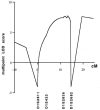Genetic linkage of the Muckle-Wells syndrome to chromosome 1q44
- PMID: 10486324
- PMCID: PMC1288238
- DOI: 10.1086/302589
Genetic linkage of the Muckle-Wells syndrome to chromosome 1q44
Abstract
The Muckle-Wells syndrome (MWS) is a hereditary inflammatory disorder characterized by acute febrile inflammatory episodes comprising abdominal pain, arthritis, and urticaria. Progressive nerve deafness develops subsequently, and, after several years, the disease is complicated by multiorgan AA-type amyloidosis (i.e., amyloidosis derived from the inflammatory serum amyloid-associated protein) (MIM 191900) with renal involvement and end-stage renal failure. The mode of inheritance is autosomal dominant, but some sporadic cases have also been described. No specific laboratory findings have been reported. The genetic basis of MWS is unknown. Using a genomewide search strategy in three families, we identified the locus responsible for MWS, at chromosome 1q44. Our results indicate that the gene is located within a 13.9-cM region between markers D1S2811 and D1S2882, with a maximum two-point LOD score of 4. 66 (recombination fraction.00) at D1S2836 when full penetrance is assumed. Further identification of the specific gene that is responsible for MWS will therefore provide the first biological element for characterizing MWS, other than doing so on the basis of its variable clinical expression.
Figures


References
Electronic-Database Information
-
- Genemap'98, http://www.ncbi.nlm.nih.gov/genemap98 (for identification of candidate genes)
-
- Généthon, http://www.genethon.fr (for microsatellite markers)
-
- National Institutes of Health FTP Site, ftp://fastlink.nih.gov/pub/fastlink (for FASTLINK software)
-
- Online Mendelian Inheritance in Man (OMIM), http://www.ncbi.nlm.nih.gov/Omim (for MWS [191900], cold hypersensitivity [120100], aquagenic urticaria [191850], mast-cell disease [154800], dermodistortive urticaria [125630], and localized heat urticaria [191950])
-
- The Lab of Statistical Genetics, Rockefeller University, ftp://linkage.rockefeller.edu/software/ (for SLINK and HOMOG software)
References
-
- Dib C, Fauré S, Fizames C, Samson D, Drouot N, Vignal A, Millasseau P, et al (1996) A comprehensive genetic map of the human genome based on 5,264 microsatellites. Nature 380:152–154 - PubMed
-
- Drenth JPH, Cuisset L, Grateau G, Vasseur C, van de Velde-Visser SD, de Jong JG, Beckmann JS, et al (1999) Mutations in the gene encoding mevalonate kinase cause hyper-IgD and periodic fever syndrome: International Hyper-IgD Study Group. Nat Genet 22:178–181 - PubMed
-
- Drenth JPH, Haagsma CJ, van der Meer JW (1994) Hyperimmunoglobulinemia D and periodic fever syndrome: the clinical spectrum in a series of 50 patients: International Hyper-IgD Study Group. Medicine (Baltimore) 73:133–144 - PubMed
-
- French FMF Consortium, The (1997) A candidate gene for familial Mediterranean fever. Nat Genet 17:25–31 - PubMed
Publication types
MeSH terms
Associated data
- Actions
- Actions
- Actions
- Actions
- Actions
- Actions
LinkOut - more resources
Full Text Sources
Other Literature Sources
Medical

